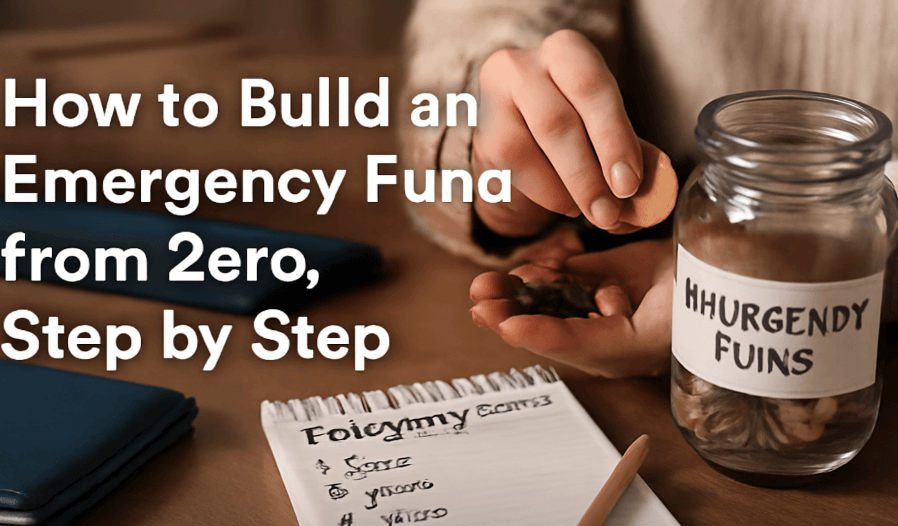Life is unpredictable. A job loss, car repair, medical bill, or even a broken appliance can catch you off guard and if you’re not prepared, these unexpected events can throw your entire budget off track. That’s where an emergency fund comes in.
An emergency fund is a dedicated amount of money set aside specifically for unplanned expenses. It acts as a financial cushion, offering peace of mind and reducing your reliance on debt when things go wrong.
In this article, you’ll learn how to start building an emergency fund from scratch even if you’re living paycheck to paycheck. No financial advice or investment strategies here just educational steps to help you feel safer and more in control.
Why You Need an Emergency Fund
Emergencies aren’t a matter of if, but when. Most people will face at least one unexpected financial event every year. Without a safety net, these moments can lead to:
- Credit card debt
- Late payments and fees
- Stress and anxiety
- Delayed goals like saving or investing
An emergency fund gives you breathing room so when life throws a curveball, you don’t have to panic.
How Much Should You Save?
The ideal amount depends on your situation, but common recommendations suggest:
- Starter emergency fund: $500–$1,000
- Full emergency fund: 3 to 6 months of essential expenses
Essential expenses include rent/mortgage, food, utilities, insurance, and transportation.
If that sounds overwhelming, don’t worry you don’t need to save it all at once. The key is to start small and build gradually.
Step-by-Step Guide to Building an Emergency Fund from Zero
Step 1: Open a Separate Savings Account
Keep your emergency fund separate from your everyday checking account. This reduces the temptation to dip into it for non-emergencies.
Look for:
- No monthly fees
- Easy access (but not too easy)
- Optional features like nickname labeling (e.g., “Emergency Fund”)
Online savings accounts often offer better interest rates than traditional banks.
Step 2: Define Your First Milestone
Instead of aiming for $5,000 right away, set a realistic short-term goal like saving your first $100 or $250.
Small wins build confidence. Once you hit that goal, set the next one. Example milestones:
- $100 → $250 → $500 → $1,000 → 1 month of expenses → 3 months
Step 3: Review Your Budget for Hidden Opportunities
You might feel like there’s no room to save, but a closer look at your budget might reveal options like:
- Cutting unused subscriptions
- Reducing takeout or delivery
- Canceling memberships you’re not using
- Buying generic brands
Even saving $10 or $20 a week adds up over time.
Step 4: Automate Your Savings
If you wait until “extra money” appears, it might never come. Instead, set up automatic transfers to your emergency fund:
- $10 every Friday
- 5% of each paycheck
- Round-ups from debit card purchases
Automation removes decision-making and keeps your savings consistent.
Step 5: Use Windfalls and Extra Money Wisely
Whenever you receive unexpected money, consider putting part or all of it into your emergency fund:
- Tax refund
- Cash gifts
- Rebates
- Freelance or side income
- Bonuses or commission
These one-time boosts can speed up your progress without affecting your regular budget.
Step 6: Avoid Dipping Into It
An emergency fund is not for:
- Vacations
- Holiday shopping
- Sales or discounts
- Non-essential upgrades
Use it only for true emergencies, like:
- Job loss
- Medical expenses
- Urgent home or car repairs
- Unexpected travel for family emergencies
If you use it for something non-critical, you risk not having it when it really matters.
Step 7: Replenish After Using It
If you need to use your emergency fund, that’s OK that’s what it’s for. But once the crisis passes, make a plan to rebuild it gradually, just like you did the first time.
Tips to Speed Up Your Emergency Fund
- Sell unused items online
- Use cashback or rewards apps and save the extra
- Take a temporary side gig (even a few hours a week)
- Meal prep to reduce food spending
- Set “no-spend” weekends or challenges
Every dollar counts. A $200 emergency fund is better than $0.
Where to Keep It (and Where Not To)
Keep your emergency fund in a liquid and safe place like a savings account. Avoid risky investments like stocks or crypto, which could lose value right when you need the money.
Don’t mix it with:
- Investment accounts
- Retirement funds
- Spending accounts
The fund should be easy to access but not so easy that you’ll be tempted to dip into it casually.
Final Thoughts: Build Safety, One Step at a Time
You don’t need a perfect budget or high income to build an emergency fund. All you need is:
- A clear goal
- A system to support it
- A commitment to stay consistent
An emergency fund isn’t just about money it’s about peace of mind. It tells your future self:
“I’ve got you covered.”
And that sense of security is one of the most powerful forms of financial freedom.
